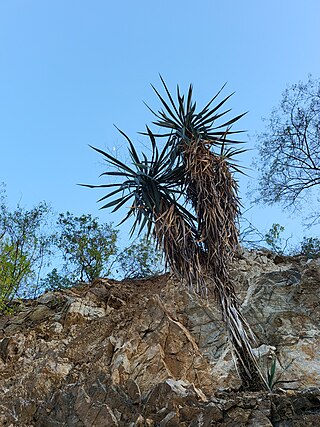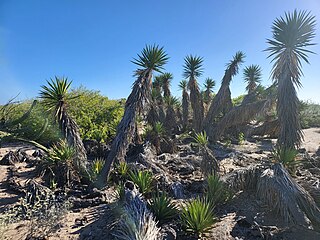
Yucca elata is a perennial plant, with common names that include soaptree, soaptree yucca, soapweed, and palmella. It is native to southwestern North America, in the Sonoran Desert and Chihuahuan Desert in the United States, southern Nevada, southwestern Utah, and northern Mexico. Yucca elata is widely distributed, although its population appears to be decreasing.
The Prodoxidae are a family of moths, generally small in size and nondescript in appearance. They include species of moderate pest status, such as the currant shoot borer, and others of considerable ecological and evolutionary interest, such as various species of "yucca moths".

Hesperoyucca whipplei, the chaparral yucca, our Lord's candle, Spanish bayonet, Quixote yucca or foothill yucca, is a species of flowering plant closely related to, and formerly usually included in, the genus Yucca. It is native to southwest communities of North America.

Tegeticula is a genus of moths of the family Prodoxidae, one of three genera known as yucca moths; they are mutualistic pollinators of various Yucca and Hesperoyucca species.
Tegeticula californica is a moth of the family Prodoxidae. It is found along the coast of southernmost California, United States.
Tegeticula tehuacana is a moth of the family Prodoxidae. It is found in Mexico in Oaxaca, western- and south-western Veracruz, and central-northern Puebla centred on the Tehuacan Valley.
Tegeticula tambasi is a moth of the family Prodoxidae. It is found in Mexico from northern central San Luis Potosí south-east to Querétaro, and south-westward beyond Morelia, Michoacán.
Tegeticula mexicana is a moth of the family Prodoxidae. It is found in the United States in Texas, New Mexico and in Mexico. The habitat consists of desert flats and low slopes in the Chihuahuan Desert and open shrubland and grassland in coastal regions.
Tegeticula maculata is a moth of the family Prodoxidae. It is found in North America in central-southern cismontane California, in the Sierra Nevada north to Fresno County, in north-western Arizona, and from Baja California Norte to the Vizcaino region. The habitat consists of coastal chaparral and montane dry shrubby grassland.
Tegeticula intermedia is a moth of the family Prodoxidae. Along with other moth species, it is commonly known as a yucca moth. T. intermedia lives in North America, particularly the United States. The moth resides in the southwest, the Great Plains, the Southeast, and mid-Atlantic. It also has been found much farther north in regions of Canada like Ontario and Alberta. There are also notable populations present in New Mexico. Their habitats are diverse and vary in terms of climate, landscape, and other factors. The moth lives in sand dunes, forests, glades, grassland, desert, and forests from the East Coast to the Southwest. Yucca moths have developed a strong mutualism with the yucca plant, such that both depend on each other for survival. The yucca moths and yucca plants have coevolved over millions of years. However, Tegeticula intermedia differs from most yucca moths in that it exhibits cheating behavior by laying eggs without pollinating the yucca plant.
Tegeticula carnerosanella is a moth of the family Prodoxidae. It is found from western Texas in the United States south to Mexico. The habitat consists of shrub desert.
Tegeticula mojavella is a moth of the family Prodoxidae. It is found in the United States in the Mojave Desert, from southern Nevada and California south to the Mexican border. The habitat consists of bajadas and lower slopes of open desert.
Tegeticula altiplanella is a moth of the family Prodoxidae. It is found in the United States in the mountains and high plains of Colorado, southern Utah, northern Arizona and New Mexico. The habitat consists of high brush deserts, rock outcrops, volcanic tuff soils in open forests and high grassland.
Tegeticula baccatella is a moth of the family Prodoxidae. It is found in the United States in Arizona and New Mexico and adjacent regions of California, Nevada, Utah and Colorado. It is also found in western Texas. The habitat consists of shrub desert, rocky hillsides and open pine forests with outcrops.
Tegeticula rostratella is a moth of the family Prodoxidae. It is found in the Big Bend region of the United States, south to the Mapimí region in southern Coahuila in Mexico. The habitat consists of scrub desert.
Tegeticula superficiella is a moth of the family Prodoxidae. It is found in the United States in south-western Utah and northern Arizona. The habitat consists of shrub desert and open pine forests.
Tegeticula corruptrix is a moth of the family Prodoxidae. It is found in North America in south-western California, Arizona, New Mexico, northern Coahuila, western and southern Texas, Colorado, Alberta, the western plains of Nebraska, Wyoming and Montana. The habitat consists of grassland, shrub desert, rocky hillsides, open pine forests and shrubby grassland.
Tegeticula cassandra is a moth of the family Prodoxidae. It is found in the United States in north-central Florida and bordering areas of Georgia. The habitat consists of open pine and pine-oak forests and open grassy areas with oak scrub.

Yucca capensisL.W.Lenz is a plant in the family Asparagaceae. It is endemic to a small region of the Mexican state of Baja California Sur It is considered to be an endangered species by the IUCN due to its small range and threats of habitat destruction. The epithet refers to the type locale is near Cabo San Lucas in the southernmost part of the peninsula. Its common name is the Cape Region yucca.

Yucca valida is a plant species in the family Asparagaceae, native to the Mexican states of Baja California, Baja California Sur, Sonora, and Sinaloa. The common name is datilillo.




